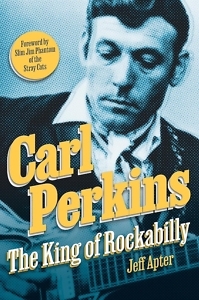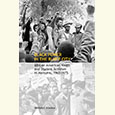An American Original
Jeff Apter surveys the life of a modest rock star in Carl Perkins: The King of Rockabilly
Carl Perkins is an unexpected choice of subject for the prolific musician biographer Jeff Apter, who lays out the life of the atypically modest rock star in Carl Perkins: The King of Rockabilly.

Apter credits No One Here Gets Out Alive, the scandalous biography about supreme hedonist Jim Morrison of The Doors, as his first inspiration. That 1980 bestseller, by Jerry Hopkins and Danny Sugarman, chronicles the live-fast-die-young life of the notoriously unstable Morrison, who rarely met a drug he didn’t love, especially alcohol, until his death in 1971 at age 27.
Perkins, who lived to be 65, is the anti-Morrison. The legend who gave the world “Blue Suede Shoes” did share the prosaic disease of alcoholism with Morrison, but that’s about it. Although Apter relates few drunken escapades by Perkins, the ones he does reveal are not barn burners:
Carl found a secluded spot near his house in Jackson [Tennessee], where he’d park, sit and drink. … [Wife] Valda eventually found out where Carl was hiding out, and when it got dark, she’d send someone to track him down.
Not exactly a wild adventure.
Luckily, there’s a lot more to Perkins than his faults. As Apter straightforwardly documents, Perkins was a legitimate rock ‘n’ roll pioneer, as influential as his more celebrated peers at Sun Records like Elvis Presley, Jerry Lee Lewis, Roy Orbison, and Johnny Cash.
 The Beatles certainly thought so. Apter points out that George Harrison, still recovering from treatment for throat cancer, flew to Jackson with his wife Olivia to attend and sing at Perkins’ 1998 funeral. Paul McCartney recruited Perkins to recording sessions in Monserrat in the Caribbean in 1981 so he could feature him on one of his best albums, Tug of War. Earlier, Perkins had the unique experience of watching The Beatles record his song “Matchbox.”
The Beatles certainly thought so. Apter points out that George Harrison, still recovering from treatment for throat cancer, flew to Jackson with his wife Olivia to attend and sing at Perkins’ 1998 funeral. Paul McCartney recruited Perkins to recording sessions in Monserrat in the Caribbean in 1981 so he could feature him on one of his best albums, Tug of War. Earlier, Perkins had the unique experience of watching The Beatles record his song “Matchbox.”
George Harrison used “Carl Harrison” as his stage name for a time, in tribute to Perkins, according to Apter. “The first record that fellow Silver Beetle John Lennon bought with his own money when he was sixteen was ‘Blue Suede Shoes,’” Apter writes.
Where Apter really excels is putting Perkins’ music in perspective.
From Perkins’ first guitar — a cigar box attached to a broom handle with two strings made from bailing wire — to his many less well-known yet influential songs (“Daddy Sang Bass,” “Dixie Fried,” “Your True Love”), Apter succeeds in showing how much more there was to Perkins than “Blue Suede Shoes.” Perkins is sometimes labeled a one-hit wonder; Apter easily shows the ridiculousness of that opinion.
He lets Cash, who employed Perkins for nearly a decade in his band when Perkins’ career was flagging, make the point:
Early on, Carl and Cash came to an agreement on one key issue — Cash would never refer to Carl as “my guitarist.” “He is, after all, Carl Perkins,” Cash wrote knowingly in his autobiography. He admitted that he never got completely comfortable with knowing that Carl was standing behind him onstage, “literally in my shadow.” Cash had the sense, with justification, that Carl didn’t get the credit he deserved. He was as much an American original as Cash himself.
If you want to know about the rock ‘n’ roll revolution that came storming out of Sun Records in the 1950s, you can’t overlook Carl Perkins. His music was as exciting as any of his peers.
Most of the things that held Perkins back weren’t his fault. He was not a matinee idol like Presley, could not compete with Lewis as a showman (who could?), and did not have an epic story of redemption like Cash. He was a modest, decent man with exceptional talent. And he used the fame he did have to fight child abuse with his Exchange Club-Carl Perkins Center for the Prevention of Child Abuse, which continues that work today in 20 Tennessee counties.
Carl Perkins: The King of Rockabilly doesn’t have the fireworks and chaos of the typical rock star tale. Perkins’ life didn’t give Apter the ammunition for that kind of story. But Apter delivers the quieter story of this under-celebrated musical hero crisply and succinctly, much like a Carl Perkins song.

Jim Patterson is a freelance writer in Nashville. His work appears regularly on the United Methodist News website, UM News. He formerly covered country music for the Associated Press and was a public affairs officer and senior writer at Vanderbilt University.


